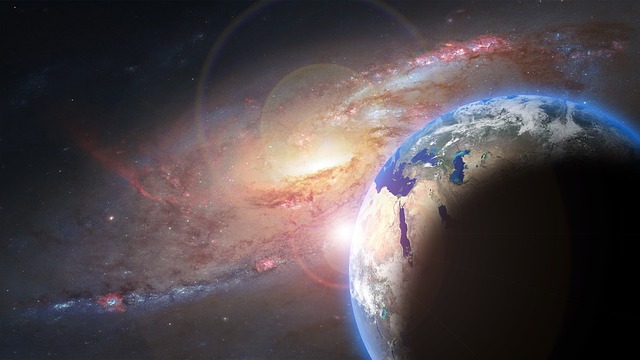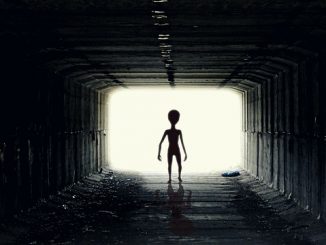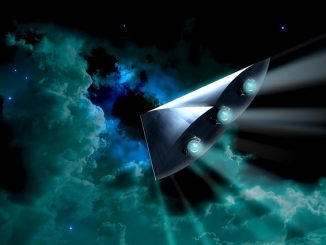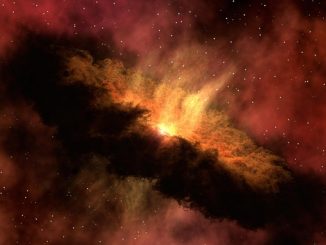
According to astronomers at St. Andrews University led by Ph.D. student Indranil Banik, they have made a discovery that challenges Einstein‘s gravitational theory. They are referring to a 10 million light year-wide ring of galaxies that display ‘uncharacteristic’ properties. That means the galaxies are not behaving like they’re supposed to based on the known laws of physics, in this case, the laws governing gravity. Instead of being pulled by gravity towards us, the galaxies seem to be running away from us at a rate that’s much faster than expected — rapidly expanding, just like a ‘mini Big Bang’.
The team believes that Andromeda (our nearest galaxy neighbor) may have once darted past our own Milky Way galaxy, and this close-range passing may have resulted in the creation of a number of dwarf galaxies scattered along the same plane where the two massive galaxies are currently located.
As Dr. Hongsheng Zhao, one of the study’s authors, said: “If Einstein’s gravity were correct, our galaxy would never come close enough to Andromeda to scatter anything that fast.”
Following that train of thought, proving that the team’s theory is correct will mean that our perception about how gravity works will need some tweaking. Because a ‘close encounter’ with a galaxy will only make sense if gravity doesn’t weaken as fast as we believe it does as it gets farther from another galaxy.
Banik describes the ‘ring-like’ distribution of the galaxies as ‘very peculiar’. He says that the small galaxies are ‘like a string of raindrops flung out from a spinning umbrella’. And that there is ‘barely a 1 in 640 chance’ that scattered galaxies will line up in such manner. He further adds that the origin of such formation is probably a dynamic event when our universe was just half of its current age.
Banik also pointed out how Einstein’s model of gravity always involved the presence of ‘dark matter’.
“Such a high speed requires 60 times the mass we see in the stars of the Milky Way and Andromeda. However, the friction between their huge halos of dark matter would result in them merging rather than flying 2.5 million light-years apart, as they must have done.”
It might take some time and definitely more in-depth study before the rationale behind this latest discovery can be fully explained (if it can be explained at all, maybe if there’s another Einstein in our midst?) And while some are saying that this might require rewriting of the Relativity Theory, shouldn’t writing of an entirely new theory be considered too? The universe is one colossal entity after all, so maybe it’s simply too profound to be explained in one all-encompassing equation.
The paper was published in ‘Monthly Notices of the Royal Astronomical Society’.
- Bulenox: Get 45% to 91% OFF ... Use Discount Code: UNO
- Risk Our Money Not Yours | Get 50% to 90% OFF ... Use Discount Code: MMBVBKSM
Disclaimer: This page contains affiliate links. If you choose to make a purchase after clicking a link, we may receive a commission at no additional cost to you. Thank you for your support!




Einstein’s theory is valid as long as the gravitational constant is fixed. But outside galaxies it appears to be greater than inside which explains what we call dark matter. I understand this is what they mean by emergent gravity. Regions of especially fast receding galaxies could be due to the primordial vacuum fluctuations which likely caused the formation of galaxies in the early universe.
Or perhaps evidence of a white hole? Hiding out there in plain sight.
As atoms turn out to be 99.99999999% empty space, one wonders where all the empty space goes when the black hole feeds. Could it be into a white hole entangled in another part of the U? Note if the entangled particles of the ones falling into black holes were antiparticles, they would not be visible in the growing white hole as I see it because antiparticles experience anti-gravity.
Read more at: https://phys.org/news/2017-02-down-to-earth-approach-gravity.html#jCp
Of course Einstein’s General Relativity is false, but Einstein’s math cleverly correlates with what is really going on, at least in the nearby visible universe. Here are two sources that destroy GR on its own terms:
http://astronomy-links.net/GGvsGR.html
http://astronomy-links.net/DipoleRepellerExplained.pdf
It looks like gravity is bit different than other “forces”, …
First idea is that there is no negative mass or north mass…
However there are strange facts about that gravity and the big bang too. It is also important to say that there might not be any elastic property to that curved space, after all … from this we have many implications, even one that the dark matter might be leftover effect of the big bang…
And with entanglement stuff.m
My theory : Gravity is what pulls galaxies together until they all fuse into one huge mass that has enough energy to cause a “big bang.” Then, it’s an outward push and we see the “universe expanding” as it is doing now – until it reaches a point of unsustainable centrifugal force. Then gravitational centripetal force becomes greater, and the process of pulling galaxies together towards another eventual “big bang” ensues. This is a cycle that occurs over many trillions of years.